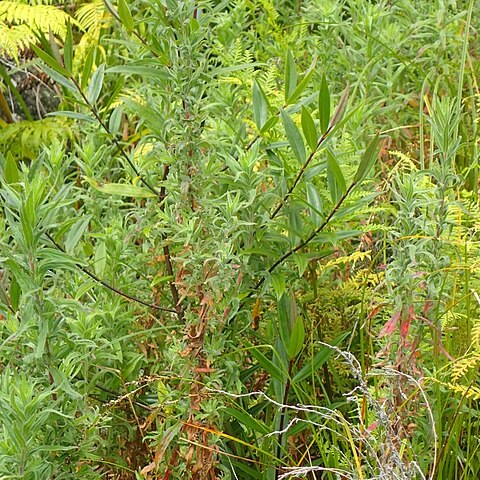Robust hirsute perennial 20–140 cm high, with numerous basal leafy stolons. Stems with dense, long, spreading hairs and usually with erect and glandular hairs; stem bases exfoliating and rather woody. Leaves usually alternate, linear or very narrowly lanceolate, 1.5–6 cm long, with distinct, spaced teeth sometimes absent from the lower parts, sometimes undulate. Flowers with a conspicuous ring of long hairs inside the hypanthium. Petals 3–8 mm long, white or purplish pink. Capsule 3.5–6 cm long, densely pubescent with a mixture of long and spreading, close and glandular hairs; pedicel to 1.5 cm long. Seeds obovoid, 0.9–1.1 mm long, comose.
Stock woody; stems several, stiff, erect from arcuate base, clad in villous hairs, simple or branched; branches ± virgate, hoary with mingled long and short hairs. Lower lvs subopp., rest alt., ± crowded, ascending, sessile or very nearly so. Lamina narrow-lanceolate, 25-50-(65) × 3-8-(10) mm., subcoriac., densely (sts sparsely) hairy, becoming glab.; margins ± entire in lower part, coarsely denticulate towards apex. Fls ± 6·5 mm. diam.; calyx-lobes lanceolate, villous; petals purplish, a little > calyx. Capsules 50-60 mm. or more long, rather stout, densely villous; peduncles 5-12 mm. long, ± pilose. Seeds densely papillose.
Robust herb, 20-140 cm tall, usually not branched, with numerous vigorous leafy stolons from base, hirsute, densely covered everywhere with long spreading hairs, and often greyish, usually with a layer of shorter erect hairs and also with glandular hairs in infl. Lvs linear to very narrowly lanceolate, 1.5-6 × 0.2-0.8 cm. Floral tube 0.5-0.9 mm deep, with a conspicuous ring of long white hairs inside. Petals white or rose-purple, 2.8-8 × 1.8-5.2 mm, often < sepals. Capsule densely hairy, 3.5-6 cm long; fruiting pedicel 0.6-1.5 cm long.

